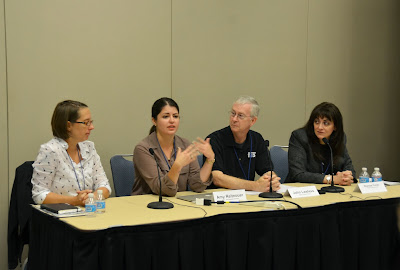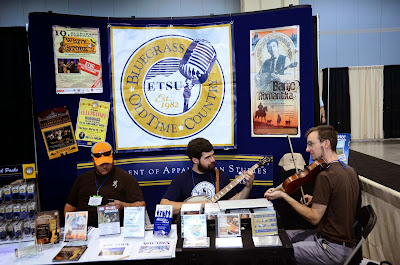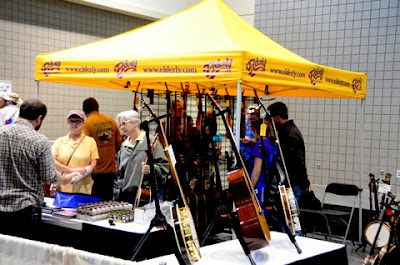Sir Walter Raleigh Welcomes IBMA to Town
The Front of the Raleigh Convention Center
While the precise numbers aren't in, and it will take a while for all that went on in Raleigh, NC this week at the International Bluegrass Music Association's annual World of Bluegrass Meeting, the consensus seems to be that a new, re-imagined, and re-invigorated IBMA has successfully held its first convention in Raleigh, and it was a smash hit from every perspective. While there were plenty of glitches and some important matters fell through the cracks, thousands of people who have been regulars at IBMA through its history at Owensboro, Louisville, and Nashville came to to town to see what was going to happen and were won over by the warmest welcome they could conceive everywhere they went. Of course there are still some grumpy folks who resent coming over the mountains from Nashville, while there are others who are better at picking holes than they are at embracing this combination of new packaging and old sounds mixed with new renderings of there delivery, but the five day event was nothing short of a triumph.
Art Menius, a founding member of IBMA and a deeply experienced bluegrass and music executive wrote, "Raleigh is a major re-framing, a sincere transformation of WOB, but much in the spirit of Tony’s [Rice] speech, it not only preserves but strengthens what is essential. This week saw the Owensboro vision of 1985-1986 brought fully to life. I wish Terry Woodward, Sonny Osborne, and Burley Phelan could have seen it. This was [the original vision] in remarkable detail almost 30 years later in a different place with different people, but I saw what we talked about all around me come to life." Over the next week, I'll try to put the event into perspective in both words and pictures. As I viewed and selected photos yesterday, I found that I had spent too much time enjoying and participating to do the job I wish I had been able to do pictorially. I want to apologize for that at the outset. Now, let's try to look at what we experienced in Raleigh, North Carolina.
Opening Reception and Keynote Address
ice sculpture
A Lovely Reception Preceded the Keynote
New IBMA Board Chairman Jon Weisberger
Welcomes the Membership to Raleigh
Keynote: Noam Pikelny
Noam Pikelny, first winner of the Steve Martin prize for Excellence in Banjo and Bluegrass, delivered the keynote address on Tuesday afternoon. With humor and humility, he emphasized the common threads holding us all together, speaking eloquently about his voyage from his earliest learning in bluegrass banjo to his realization that he must follow his own creative muse wherever it takes him. He spoke with fervor about his belief that whatever directions some bluegrass takes, there will always be those who will find their way back to Bill Monroe and the other first generation creative geniuses who set us on the road and whose music continues to influence and inform bluegrass music. David Menconi wrote in the online edition of the Raleigh News Observer, "But the reason bluegrass is on the rise, Pikelny said, is that it’s “overflowing with authenticity” compared to the pop mainstream. And while some acts passing for bluegrass nowadays might have given Bill Monroe pause, Pikelny argued that all this attention is still a net positive...I’m not asking you to embrace any music or musicians just because they’re wrapped in this flag of bluegrass that’s been so near and dear to us for so long,” he said. “I’m asking you to acknowledge that the definition of bluegrass has always been ethereal, and not to get bogged down in debates over what is bluegrass and what is not.” I'm eager to read the published version of Pikelny's fine speech to glean other gems from it. The audience rewarded the balanced, sometimes humorous, and always thoughtful presentation with a standing ovation.
Bill Knowlton
Seminars and Workshops
Nancy Cardwell Holds Orientation

The lines between business and entertainment at World of Bluegrass sometimes become pretty blurred, as they should. The business of bluegrass relies on bringing the talent (performers) together with the buyers (promoters, recording company executives, booking agents, artist management, equipment manufacturers, publishers, and other constituencies) together in an environment where the names that have become familiar can become faces and personalities which can interact in a more personal and engaged environment. Often the initial contact as well as the nurturing of previous ones takes place at IBMA. At seminars and receptions, in showcases and the Convention Center hallways, along the streets, and in hotel rooms and suites the business of bluegrass music is conducted. It all sometimes seems overwhelming, the buying and selling, the trying to make a good impression and generate further business, but those wishing to succeed must work at it to take advantage of every minute available. And no one can cover or experience it all.
Panel
Kim Ruehl (No Depression), Amy Reitnouer (The Blugrass Situation),
John Lawless (Bluegrass Today), and Shannon Wayne Turner (Freelance Writer)
It's rare that artists and media people can come together to explore and discuss the emerging and crucial world of e-commerce. Here, four most important media titans talk and answer questions about the emerging world of online publication and publicity without any holding back. This seminar was packed, as were almost all those held, with those wishing to have greater impact in letting the world know what they're doing.
Women in Bluegrass - Pretty Good for a Girl
The publication of Murphy Henry's new book Pretty Good for a Girl: Women in Bluegrass became the occasion for this panel of distinquished and varied women to examine the problems and joys of developing and expanding the role of women in bluegrass from the perspective of performers. The panel on women in bluegrass business is yet to be held, but is surely soon to come, with or without a book. The panel attracted a standing room crowd for a lively discussion, at once intriguing, controversial, moving, and funny.Participants there learned, many shared, and all who cared to listen came away with new and enlarged perspectives and understandings.
Gina Britt, Kimber Ludiker, Laurie Lewis, Murphy Hicks Henry,
Kathy Kallick & Annie Staninec

Showcase Luncheon
Official showcases present a series of bands to those who can help them develop their businesses in every way. They are selected by a showcase committee on application to perform. Twenty-five bands were selected to showcase and they performed on stage at the Convention Center and on the Bluegrass Ramble at six locations within walking distance throughout the full five days. Each showcase band was guaranteed several performances. All told there were 168 opportunities to showcase in quiet and noisy, nearby and more remote official locations. Add to that the numerous opportunities during the two days of Wide Open Bluegrass, and it becomes obvious that, with planning, it was easy to see and evaluate many bands.
Kathy Kallick Band at the Showcase Luncheon
Dave Adkins
Jim Beaver (DJ) and Roger Moss (Promoter)
Vickie Vaughn Band
Master Workshop Stage
Every day the Master Workshop stage featured performances as well as question & answer sessions focused on instruments and special kinds of presentations that were always well attended.
Bluegrass Pioneers
Lily Pavlek, Sir Walter Raleigh & Al Hawkes
The Exhibit Hall
The Exhibit Hall functioned as a link between the Business Conference and Wide Open Bluegrass. Several kinds of commerce take place in the exhibit hall and networking is crucial there. People do purchase things, but the face-to-face opportunities between all constituencies in the bluegrass business take place in the exhibit hall. It's a lively and crowded marketplace, like a small town open street on market day. An impressive and large scale exhibit called the North Carolina Pavilion dominated a corner of the hall featuring bands, products, and business instruments from within the state as well as sponsoring some seminars and workshops.
Deering Banjos
Old Time Music
Trying Out Instruments and Jamming
D'Addario Strings
Elderly Instruments
The North Carolina Pavilion
Mark "Brink" Brinkman & Niall Toner
Jamming in the Hallway
WAMU's Bluegrass Country
Each year WAMU's Bluegrass Country, a major World of Bluegrass sponsor, hosts four days of live radio broadcasts in a room turned into a radio studio, featuring six bands a day. These shows, part of a live broadcast to the home station in Washington, D.C. heard on 105.5 FM in Washington and streamed worldwide at Bluegrass Country.org programs established and emerging bands. The studio is usually crowded and sometimes packed to the gills. The music in the room is acoustic and the audience is asked to maintain silence during performances and to cheer loudly when appropriate. This year, the Bluegrass Country staff also traveled to the North Carolina Museum of Natural Science to present a special evening program in a brand new studio there featuring Doyle Lawson & Quicksilver as well as Joe Newberry and his band.
The Kathy Kallick Band at Bluegrass Country
Lorraine Jordan & Carolina Road at Bluegrass Country
Doyle Lawson & Quicksilver, Lee Michael Demsey & Katy Daley
Having a While of a Time at the Museum
The Studio from a Remote Theater
The Grass Cats with Katy Daley
In the Studio
The Bluegrass Ramble
at the Pour House
The Bluegrass Ramble represents a major change in presenting showcase bands. Using five bars, a converted church, and the Convention Center as performance venues, World of Bluegrass registrants using their registration tags and other people paying individual admission at each venue were treated to a huge variety of styles and approaches to bluegrass music. Bands were able to strut their stuff in the kinds of venues where they actually play, and talent buyers could see real reactions from genuine music lovers to these performances. While requiring some degree of mobility to get to most of the venues, they were generally seen as an enormous opportunity to both bands and buyers as well as the general public. Next year, participants will know better how to utilize these marvelous opportunities.
Johnny Staats at the Pour House
Red Wine at the Pour House
The Audience at the Pour House
Brooke Aldridge
The Awards shows on Wednesday


















































